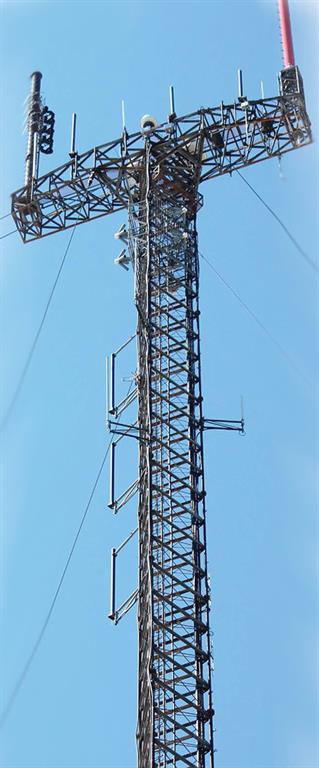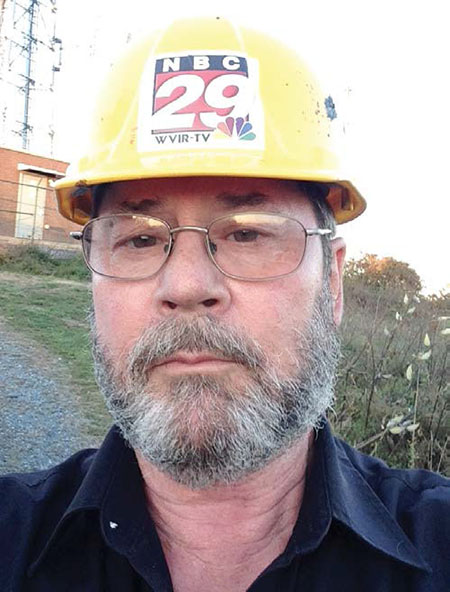Broadcasters Face Complex Repack

Photo credit: James O’Neal
ALEXANDRIA, VA.—The United States is at the cusp of yet another television spectrum repacking operation. This makes number three, if you count the first TV broadcast spectrum reallocation in 1940 (although there weren’t really that many stations then). There was the big upset beginning in 1952 when the FCC’s four-year “freeze” on new station applications ended; nearly a third of the 108 stations then on the air had to shift frequencies. And of course we all remember the 2009 repack. (The loss of channels 70-83 to land mobile a few decades earlier doesn’t really count, as by that time there wasn’t much TV broadcast activity up there.)
Somehow, we managed to survive all of these disruptions and over-the-air television is still very much alive. There’s no reason to believe this latest bit of spectrum reallocation will be the death knell for U.S. television broadcasting. However, it is making for some interesting situations, aside from the “expected” dilemmas involving shortages of tower crews, new equipment lead-times, lack of “loaner” channels, station hosting and the changeout “ripple effect.”

Bill Meintel
NEW HOMES
One of these involves new homes for displaced television stations. The available real estate for new homes is not always in the best neighborhood. Problems with Channel 14 have been flagged (and experienced) previously, but according to data on the www.rabbitears.info website, some 32 stations will be joining the 14 already there. Bill Meintel of the consulting firm of Meintel, Sgrignoli & Wallace, says these moves will likely end badly.
“The obvious problem with Channel 14 are the adjacent land mobile stations that have to be protected,” he said. “This involves filtering and other items, which—even though the government is going to pay for it—can be problematic. In the case of one of our clients reassigned to Channel 14, there’s no room in their transmitter building for such a filter and they don’t have room to expand the building. Also, this will probably preclude them from doing any maximization later on.”
A Channel 14 operation in the San Francisco area has been running reduced power on STAs for years due to land mobile interference issues, according to Meintel. “They’ve spent around half a million dollars and still haven’t been able to solve the interference problem.”
Get the TV Tech Newsletter
The professional video industry's #1 source for news, trends and product and tech information. Sign up below.
Meintel also flagged issues—other than drawing a Channel 14 assignment—facing operations having to relocate.
“A number of these stations are going to have problems where they don’t have room in the building or on the tower, no room to expand,” he said. “We’re looking at one situation where several stations are sharing an antenna and combiner. They can’t shift off until they go with the new one, but the building isn’t big enough for the new gear. It’s about the size of a semi.”
One reason that a fairly large number of UHF stations are migrating to Channel 14 is that they can’t be forced to take a VHF assignment, Meintel said. “They had to find you a UHF channel. It’s not surprising that a number of stations wound up on 14.”

Bob Jenkins
Some U stations, though, are accepting V real estate. One of these is Charlottesville, Va.’s WVIR-TV, which has been operating on Channel 32 since the 2009 repack, but the NBC afilliate will be setting up shop on Channel 2, according to chief engineer, Bob Jenkins.
“We’re not really happy with it, but we didn’t have a lot of choices,” he said. “We could take the money and go off the air, or hopefully, channel share with another station, or we could take the money and go to Channel 2.”
Jenkins noted that when his station moves to its new channel, there may be problems in reaching all of their existing viewers.
“FCC modeling says [the new facility] will replicate our coverage, but when you deal with the real-world noise and everything else, that may not be the case,” he said. “We may have to install some small ‘gap fillers.’”
MUSICAL CHAIRS
In describing the WVIRTV move, Jenkins observed a pattern that seems to be occurring in some markets.
“There are three other stations in our market,” he said. “Channel 19 here is relocating to our [existing] Channel 32. We could have just lowered our power. All of the transmitters are on the same mountain, about 400 or 500 feet apart.”
A similar “musical chairs” situation exists in the Hartford/New Haven, Conn. market. It takes the form of four UHF stations changing assignments:
● WVIT (Channel 35) moves to Channel 31, currently occupied by WTIC-TV;
● WTIC-TV moves to Channel 34;
● WCCT-TV (Channel 20 and licensed to Waterbury, Conn.), shifts to Channel 33, and
● WFSB (Channel 33) relocates to Channel 36.
An engineer at one of the impacted stations, who asked not to be identified, questioned the logic of these shifts.
“Connecticut is a small state with most of these transmitter sites located just a stone’s throw from each other,” he said. “WTIC-TV’s tower is actually only 1,100 feet away from WVIT’s.
“What’s wrong with keeping WTIC on Channel 31 and WFSB on Channel 33, and only shifting two stations, WVIT and WCCT, instead of this round-robin involving four stations?” he continued. “If it’s an adjacent channel consideration, you’re still going to wind up with channels 33 and 34 operating only a few miles apart. Is this pattern being repeated in other markets?”
He also noted that Connecticut station WEDH, will be moving (Channel 45 to Channel 30), creating another adjacent channel situation with WVIT (Channel 31).
VHF CONSIDERATIONS
The laws of physics surface in a big way in going from U to V, with much longer wavelengths and proportionally larger (and heavier) transmitting antennas. Replacement of a UHF model with a VHF radiator will require some serious tower and wind-loading studies, possibly requiring structural mods, or even a new tower. (Meintel notes that this could also be a problem for UHF stations staying with the U band.)
“Even if you’re moving from Channel 45 to 25, that antenna is going to be a lot bigger and a lot heavier, which is going to be a problem because there are a number of towers out there that can’t support that extra weight,” Meintel said.
A height increase stemming from installation of a larger top-mounted VHF antenna could also trigger FAA concerns.
Lower frequencies could also pose another potential problem, especially in the low-band 54 to 88 MHz region, where wavelengths are ponderously long. This could surface when ATSC 3.0, with its greatly enhanced mobile TV capabilities, is implemented. To be efficient, a receiving antenna length needs to approximate an appreciable portion of a wavelength; something not really practical with handheld viewing devices at lower VHF frequencies. Time will tell, but it’s not likely that a physically short antenna can be engineered to deliver an adequate signal for these viewing devices.
Disadvantages or not, according to rabbitears.info, 17 UHF stations will be moving to low-V slots, and another 13 are relocating to high-band V positions. (Only one broadcaster, Pittsburgh’s WQED, is moving from high-band to low—Channel 13 to Channel 2.)
MAD UHF
Aside from the abundant noise floor in VHF spectrum, RF consultant and TV Technology columnist Charlie Rhodes has been raising another channel repacking interference red flag for several years, but says few have been paying attention. This is the potential for “mutual self-destruction” among UHF stations that are assigned channels too close together in frequency. He has done the math, and also considerable laboratory testing, and says the danger from intermodulation components is real, especially given the poor tuner design in some sets nowadays. However, no one in charge seems to want to acknowledge this.
“The FCC’s job has been to get that spectrum and that’s now done,” said Rhodes. “There’s going to be interference. It could be my ox that’s gored by the interference rather than your ox.
“There is simply not one broadcaster right now that knows where he stands in terms of interference when the moves are done,” he continued. “They just won’t know until everyone has moved to their new channels and are operating with maximum authorized power.”
OTHER REPACK ISSUES
A corporate RF systems engineer for a major television broadcast group, who spoke under condition of anonymity, brought up another not insignificant repack problem—money.
“I think that, at the moment, the greatest pain for me is ascertaining what is going to be reimbursable,” he said. “We have very little formal guidance from the commission and its repack administrator at this time. Our financial people are asking for an expenditure forecast on a quarterly basis over the next four years. They would prefer to have it on a month-to-month basis.
“With transmitter costs, transmission line costs, filter costs and others, you really have to know what the reimbursement will be, sooner, rather than later,” he continued. “We can submit our claims to the commission and see if they will be approved, but you can imagine what the reaction of our finance people will be if claims are rejected. This is one of the biggest issues that we face going forward.”

Charlie Rhodes
Harvey Arnold, vice president of engineering for the Sinclair Broadcast Group and its numerous television stations, flagged some other issues associated with the repack.
“The biggest problem is that of time and money,” he said. “Accomplishing this repack within three years will require tremendous coordination and ability to work together. This must be a partnership between broadcasters and the FCC. Also, in some markets we’re up against different phases of the repack on the same tower.
“We recently gave the FCC a tour of [Washington, D.C.’s] WJLA/WUSA [shared] transmission facility, and explained some of the repack issues that will impact broadcasters.” Arnold continued. “These stations are not moving, but three others operating from this facility are. Building space is quite limited and the multichannel combiner and three UHF transmitters need to be replaced. The stations will need to carefully plan this move to limit impact to viewers. We can’t disenfranchise our viewers.
“We’re just trying to put a little sanity into this,” Arnold added. “Everyone needs to work together—no fighting. If everyone cooperates, including the FCC, we hope to get this huge project done on time.”
Despite all the potential headaches associated with this latest channel shuffle, most players are confident that over-the-air TV will be around for a long time.
To follow our online coverage, visit our repack silo, www.tvtechnology.com/repack.
